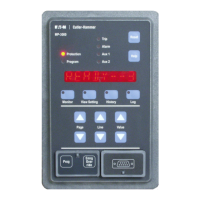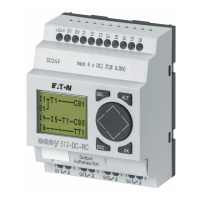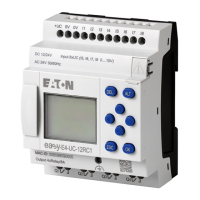Page 4-7
IL17569
Effective June, 2001
4.6.1.3 Selecting the “Energy” Sub-menu
This section allows the user to view the following Energy param-
eters (See Display 4.6).
• Watt Energy Hours (Forward, Reverse, Net)
• Var Energy Hours (Lead, Lag, Net)
• VA Hours
• Start Date and Time stamp the Unit started measuring
Display 4.6 Energy Sub-menu
The FP-5000 uses the positive sign convention for power measure-
ment. A positive sign convention corresponds to:
• Inductive load = lagging power factor = positive Var and power
factor values.
• Capacitive load = leading power factor = negative Var and power
factor values.
Hence the Forward watt-hours and the Lagging Var-hours are
positive, while the Reverse watt-hour and the Leading Var-hour
displays represent negative values.
The Forward watt-hours, Reverse watt-hours, Leading Var-hours,
Lagging Var-hours and VA-hours are all displayed as unsigned
numbers. However, when the FP-5000 calculates the Net watt-hours
and the Net Var-hours, the calculation is based on the sign
convention, therefore the Net watt-hours and the Net Var-hours can
be positive or negative values. Refer to the Power Quadrant
diagram in Figure 4.4.
A lagging power factor is displayed as a positive value and a
leading power factor is displayed as a negative value. The maxi-
mum power factor is the most lagging power factor value measured
by the FP-5000 and the minimum power factor is the most leading
power factor value measured. Two examples for min/max power
factor values are shown in Figure 4.3.
The following examples define the sign convention for energy under
various power flow conditions:
• Induction Motor Load (Figures 4.4 and 4.5)
Typically when monitoring induction motor loads, the power flow is
in Quadrant 4. The watts are positive and the power factor is
lagging. By definition, the power factor and Vars are positive.
• Capacitive Load (Figure 4.4)
When monitoring a capacitive load or a heavily excited synchro-
nous motor, the power flow is in Quadrant 1. By definition, the
power factor and Vars are negative.
System Watt Hour
Fwd kWh Magnitude
Rev kWh Magnitude
Net kWh Magnitude
System var Hours
Lead kvarh Magnitude
Lag kvarh Magnitude
Net kvarh Magnitude
System VA Hours
kVAh Magnitude
Start Date
Date mm/dd/yy
Time hh:mm:ss
QUADRANT 2 QUADRANT 1
Watts Negative Watts Positive
Vars Negative Vars Negative
Power Factor Lagging (+) Power Factor Leading (-)
Real Power
Watts Negative Watts Positive
Vars Positive Vars Positive
Power Factor Leading (-) Power Factor Lagging (+)
QUADRANT 3 QUADRANT 4
Reactive Power
Figure 4-4. Power Quadrants
Figure 4-3. Power Factor Minimum/Maximum

